Contrary Realities and Glaring Disparities
By Farida Shaheed | Women | Published 6 years ago
Contrary realities and glaring disparities characterise women in Pakistan. On the one hand, tech-savvy experts, high-powered businesswomen and professionals ably negotiate and contribute to the private sector; fearless rights activists have earned worldwide recognition and served as Special Rapporteurs on the United Nations’ Human Rights Council. Equally fearless women are blazing trails in communities and civil society, leveraging social transformation, advocating pro-poor policies, speaking truth to power. Women are making their mark in the political arena. We have highly qualified women in the health and education sectors, bureaucracy, media and academia. From astrophysics to social and economic sciences, women are making a mark everywhere. Pakistan has women pilots, commandos, police officers and mountain climbers as well as artists, musicians and dramatists.
Yet, on the other hand, the abysmal state of the majority means that for several years running Pakistan ranked as the second worst country in the world for gender equality, by the World Economic Forum. On a scale where 1.0 represents parity and 0 imparity, Pakistan scored 0.546 – the worst in South Asia. Disturbingly, gender disparity may be widening; a decade ago we ranked 112 out of 115.
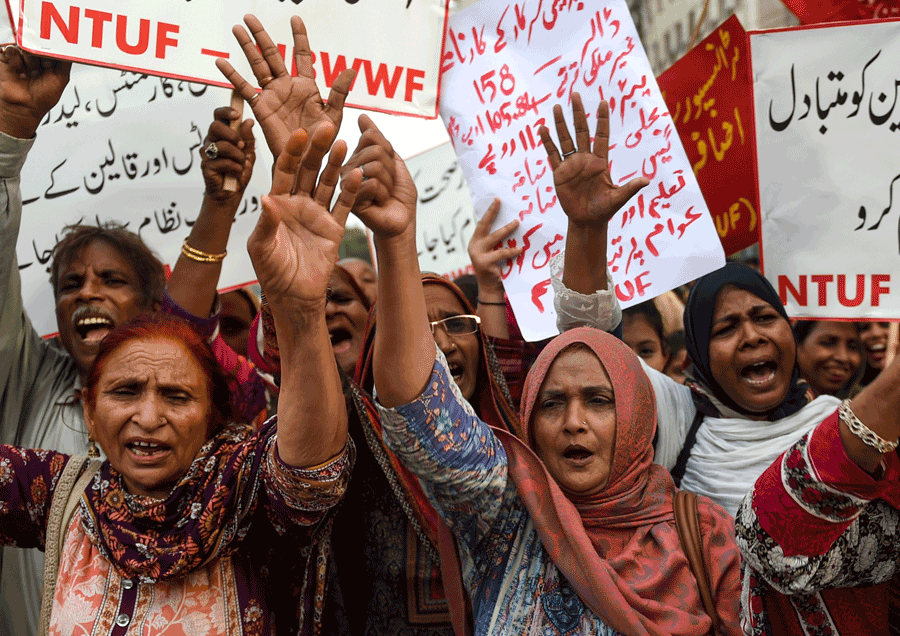
Reaction to the 2019 budget: Home-based women workers protesting against price hikes.
With so much talent, how is it that among 144 countries we rank just above war-ravaged Yemen and actually below war-torn Syria (at 142)? The answer is the deeply entrenched patriarchal values and norms, combined with a lack of serious political will even 72 years after independence.
We deny women gainful employment, despite evidence of the International Labour Organisation (ILO) that women’s labour tends to displace child labour, not men’s.
Official statistics show that women only constitute 22.5 per cent of the overall civilian labour force, 13.5 per cent of the urban labour force; lower than other countries with similar income levels. Women are concentrated in low-paid job categories where the gender pay gap is larger than in high-paid jobs. On average, women’s earning are only 60 per cent of men’s earnings; the 26 per cent gender pay gap is higher than the global pay gap. Almost two-fifths (38 per cent) earn only up to Rs 5,000 a month, well below minimum wages, while more than two-thirds (68 per cent) earn less than Rs 15,000 a month even though the government proposes to raise the minimum wage to Rs. 17,500! At 8.27 per cent, female unemployment is almost double that of men (5.07).
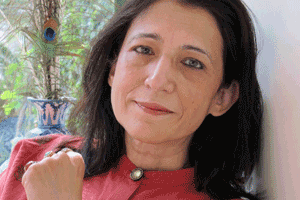
Ayesha Jalal: Academic
Nearly 75 per cent of the female workforce is employed in agriculture, but this work is undercounted in Labour Force Surveys, and not reflected as a contribution to the economy. Most of those who are self-employed and those contributing as agricultural family workers, where employment is vulnerable to seasonal and economic shocks, are women. The overwhelming majority of women workers are excluded from safety nets and benefits because they work in the informal sector, are self-employed or contributing family workers. Some 12.5 million women work as domestic and home-based workers; the vast majority without legal recognition and protection. Paradoxically, participation decreases as educational attainment rises, and according to the ILO, women occupy only three percent of the managerial positions, placing Pakistan at 108 among 126 countries.
It is high time we recognise that the deeply embedded and rigid patriarchal norms operative in Pakistan are not only damaging for women and girls but profoundly detrimental to the country, impeding progress on all fronts. Even in terms of women’s traditional normative roles as mothers, home-carers, auxillary workers etc., the picture is bleak. Social norms making health services a taboo for young girls in particular are killers, all too often literally, and lead to serious health issues. While maternal mortality rates have steadily declined (by 3.26 per cent to 178.00 per 100,000 live births in 2015), Pakistan’s ranking in the Mother Mortality Ratio Index actually dropped from 147 in 2014 to 149 in 2015 with a staggering 276 deaths per 100,000 births. We have the third highest rate of infant mortality in the world, a proxy for the level of social development as it reflects the level of nutrition, parents’ education and access to health services.
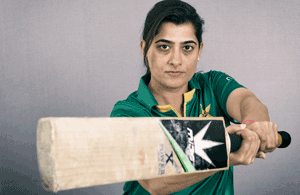
Sana Mir: Cricket Captain
We are failing spectacularly to ensure girls’ fundamental right to education up to 16 years of age under Article 25-A. Female literacy has inched up to 51.8 per cent but at the current pace of 1-2 per cent increases, it will take half a century to ensure 100 per cent literacy. Enrolment rates may be impressive, but retention and completion are a serious problem. (The reproduction of damaging gender roles in textbooks is a separate problem.) Hurdles to access include the long distances to schools, the lack of affordable transport, insecurity in traversing public spaces, and a refusal to integrate make all primary schools co-educational in a resource-constrained country with unacceptably low budget allocations. A serious social obstacle is a widespread compulsion to marry off girls as soon as they hit puberty, propelled by arrangements made by family elders to expand or consolidate social capital, or to make money; the fear of losing out on ‘good marriage prospects’ and/or malicious gossip of neighbours or relatives; and strange beliefs masquerading as religious tenets. For example, if a girl spends her second menstrual cycle at her natal home, her parents’ hajj will not be accepted or that parents will have to drink her menstrual blood in the hereafter. It does not help that maulvis promote early marriages from the pulpit and admonish those whose pubescent girls are unmarried.
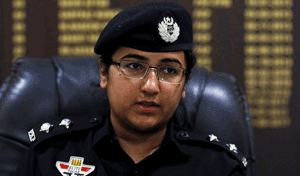
Suhai Aziz Talpur: ASP
Child marriages are just one form of Violence Against Women and Girls (VAWG) that is routinised and normalised. A study by Shirkat Gah–Women’s Resource Centre found a shocking amount of force being used, including physical violence, to mould girls as young as 5-7 years into the normative sanctioned female identity, which denies them the right to education, play, mobility and exploring their human potential. Sadly, like proverbial ostriches, officials prefer to ignore VAWG. Instead of tackling it on a war footing, surveys on gender-based violence are frowned upon. Exceptionally, the Pakistan Demographic and Health Survey (PDHS) gathers some data. VAWG-related results of the PDHS 2017-18 have not been released yet, but the 2013-14 survey revealed that one-third of women and girls aged 15-49 had experienced physical violence. This excludes verbal, psychological and sexual abuse. Victim-blaming and the stigma attached to acknowledging violence means its actual prevalence is likely to be much higher.
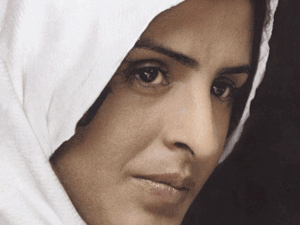
Mukhtar Mai: Activist
Rays of hope, slim though these may be, include the recent domestic violence laws passed in Sindh, Balochistan and Punjab. Since 2016, legal amendments have expanded what is considered to be the an offences of sexual violence and modified procedural laws for more effective prosecution. Murders under the pretext of ‘honour’ must be punished, even if heirs pardon or compromise with the killer. Provincial governments can no longer commute sentences in instances of honour killing, stripping a woman naked in public, or rape. Out-of-court settlements by forcing a woman to marry the perpetrator of the crime are prohibited in any civil liability or a criminal case. Cruelty to a child has been added as an offence in the PPC; as have new offences such as exposing a child to seduction, child pornography and sexual abuse. Sindh has revised the minimum age of marriage to 18 for girls, at par with boys, and enhanced punishments for forced marriages of girls under-16 and non-Muslims. Following the piloting of a special court to deal with gender-based violence in Lahore, the Chief Justice of Pakistan has announced the establishment of 116 such courts across the country for which judges are currently being trained. While the laws are not without problems and implementation remains a challenge, at least VAWG has been recognised as an issue deserving attention.
In 2018, domestic workers in Punjab and home-based workers in Sindh gained legal recognition and protection. In Sindh, a new bill proposes extending legal coverage and protection to women agricultural workers. The Benazir Income Support Programme (BISP), administered through women, has benefited 5.7 million of the poorest families. Through the Waseela-e-Taleem some 2.1 million children have gained access to education, though it is unclear how many girls are beneficiaries.
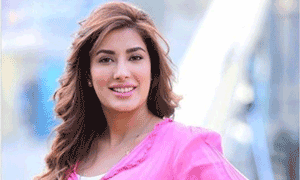
Mahwish Hayat: Actor
Women legislators, including many on reserved seats, have proved their mettle, leading the way on important legislation, including several of the above-mentioned laws. The Election Act 2017 makes a 10 per cent female voter turnout and five per cent female candidates mandatory. The 28.6 per cent overall turnout of women in the July 20 elections in the erstwhile FATA districts is encouraging, given the Taliban-created havoc not so long ago. Yet, fewer women were returned on general seats than previously. Unfortunately, the new Local Government Acts in Punjab and Khyber Pakhtunkhwa have eliminated the district and UC councils, removing key staging posts for grassroots women entering the political process.
To ameliorate the state of women in Pakistan, beyond individual achievements and excellence – demands not only that the state put its money where its mouth is, but also that the state must also put its mouth where at least some of its money is; unless the state changes its gender narrative, things will not change on the ground. A new narrative supporting women and girls as entitled rights-holding citizens is the need of the hour. It is imperative to proactively dispel the nonsensical notions that drive child marriages; change the attitude of government service-providers to address the unmet demands for family planning; project the value of girls’ education and women’s gainful employment, including in the civil services, through all means necessary, which is vital to filling the government quotas and on paper promises into reality. Without such a change in narrative, Pakistan will never be able to progress. It will remain a bird with a broken wing, doomed forever to flounder on the ground, desperately beating its wings in vain, never unable to take flight.


